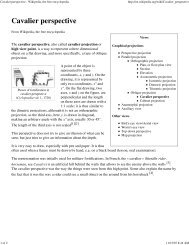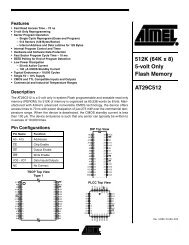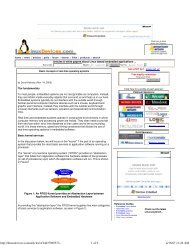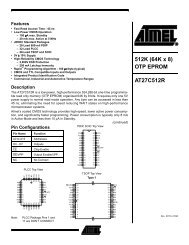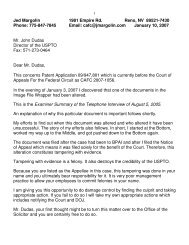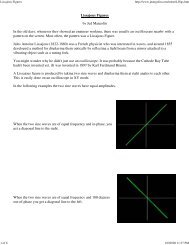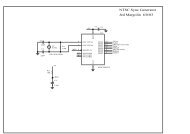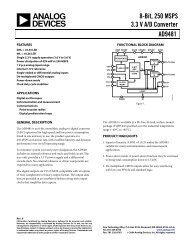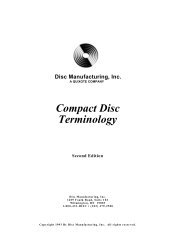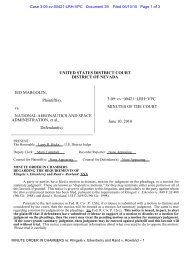Tom Taormina, K5RC
Tom Taormina, K5RC
Tom Taormina, K5RC
You also want an ePaper? Increase the reach of your titles
YUMPU automatically turns print PDFs into web optimized ePapers that Google loves.
<strong>Tom</strong> <strong>Taormina</strong>, <strong>K5RC</strong><br />
Amateur Radio Emergency Coordinator<br />
Storey County NV<br />
Attachment to Building Permit Application<br />
Amateur Radio<br />
Antenna Support Structures<br />
Submitted to the Storey County Building Department<br />
August 13, 2008<br />
370 Panamint Rd VC Highlands NV 89521 775-847-7929 FAX 775-847-7930 <strong>Tom</strong>@<strong>K5RC</strong>.cc www.<strong>K5RC</strong>.cc
Background<br />
Attachment to Building Permit Application<br />
For Amateur Radio Antenna Support Structures<br />
This is a postconstruction application for four amateur radio antenna support<br />
structures erected between 1997 and 2007.<br />
Structure<br />
Name<br />
40 Meter<br />
Rohn 45G<br />
Model Erected Height<br />
Above Base<br />
Work<br />
Rohn 45G 1997 140’ Tower<br />
raised to<br />
140’ on<br />
July 17.<br />
Replace<br />
existing<br />
Yagi @70’<br />
and add<br />
second<br />
Yagi @<br />
140’.<br />
Photo<br />
20 Meter<br />
Rohn 25G<br />
160 Meter<br />
Rohn 25G<br />
Rohn 25G 1998 85’ Antenna<br />
work only.<br />
Replace 5<br />
element<br />
20M Yagi<br />
with 6<br />
element<br />
20M Yagi.<br />
Remove<br />
440MHz<br />
repeater<br />
antenna.<br />
Rohn 25G 2007 110’ One guy<br />
anchor on<br />
Blake<br />
property.<br />
New base<br />
and anchor<br />
in place.<br />
8/13/2008 6:58:00 PM 2 080813 Towers Permit App_v3.doc
20 Meter<br />
Rohn 45G<br />
Rohn 45G 2007 140’ Remove<br />
C31XR and<br />
replace<br />
with third<br />
6 el 20M<br />
Yagi.<br />
Since moving to the Highlands in 1997, the Applicant has been repeatedly told by<br />
the Storey County Building Department and County Manager that amateur radio<br />
antenna support structures did not require building permits and, until 1999, were<br />
not considered “structures” per se. Prior to 1999, there was no height limit for<br />
amateur radio antenna support structures in then SCC §17.12.020 Building height,<br />
which was limited by its terms to “buildings and trailers.” See Exhibit G of this<br />
document. The Applicant has also been told by the Building Department and<br />
County Manager, on more than one occasion, that the 1999 revision to the SCC<br />
with respect to building height, now found at SCC §17.12.044, was a direct result of<br />
the first two towers being erected on Lot 37 of Highland Ranches, but that the<br />
Applicant was “grandfathered,” and that “he could do whatever he wanted to do”<br />
with amateur radio antenna support structures.<br />
While the 1999 revision to the SCC expands the coverage of height restrictions, and<br />
purports to impose a firm, fixed and unvarying 45’ height limitation on amateur<br />
radio antenna support structures, the fixed 45’ height limit is void as a result of<br />
NRS 278.02085 1 . This argument is extensively supported in the Applicant’s<br />
Supplement to this Building Permit Application.<br />
Exhibit B contains wording recommending a variance be applied for. Until a Stop<br />
Work Order (Exhibit A) was issued on July 17, 2008, however, the Applicant<br />
believed in good faith that he was in compliance with all ordinances, statues and<br />
regulations with regard to the then existing antenna support structures.<br />
Notwithstanding that belief, the Applicant now seeks a building permit for the<br />
existing structures exceeding 45 feet in height 2 .<br />
Exhibit E shows the placement of these structures on Lot 37. These structures<br />
were designed and installed in accordance with TIA/EIA222, as required by IBC<br />
§3108.4, and in compliance with the wind loading requirements of IBC §3108.6. All<br />
towers are permanently and effectively grounded (IBC §3108.7).<br />
1<br />
See the quotations, citations and argument in the accompanying Supplement.<br />
2<br />
The Applicant has separately filed, on July 25, 2008, an application for two antenna support structures<br />
below the height of 45’, for which he sees, with or without the effect of NRS 278.02085, the grant of a<br />
building permit as a ministerial act.<br />
8/13/2008 6:58:00 PM 3 080813 Towers Permit App_v3.doc
Exhibit F is an Opinion on suitability from Lawrence M. Prater, P.E., Ltd., which he<br />
wrote for the VHF Trylon 1245and Rohn HBX32 towers 3 . Mr. Prater is a Civil<br />
Engineer, not a Structural Engineer. As such, he declines to stamp an opinion on<br />
structures over 45’. During his visit, he did inspect ALL structures at the site and<br />
offered his view that the structures over 45’ in height were adequate for their<br />
intended purposes. He has made himself available to discuss his inspection results<br />
with the County. As a longtime resident of the Highlands and a member of the<br />
Storey County Planning Commission, his observations and opinions should be given<br />
the weight due his expertise and experience.<br />
The Highland Ranches Property Owner’s Association (HRPOA) has also opined on<br />
numerous occasions that the CC&R’s do not cover amateur radio antenna support<br />
structures. See letter exhibit in accompanying Supplement.<br />
Exhibit A was served by Dean Haymore on July 17, 2008. The Applicant complied,<br />
and completion of the structure, as well as erection of the antennas was<br />
discontinued pending resolution of the matter. This application is submitted for the<br />
purpose of complying with all laws.<br />
Request<br />
The Applicant hereby requests a building permit for these four structures, as they<br />
are amateur radio antenna support structures that are “as of right” construction,<br />
because NRS 278.020.85 makes the height restriction of SCC §17.12.044, as applied to these<br />
structures, void.<br />
3<br />
Included in the Building Permit Application of July 25, 2008.<br />
8/13/2008 6:58:00 PM 4 080813 Towers Permit App_v3.doc
Description of Each Structure<br />
40 Meter Rohn 25G 140’<br />
This support is footed in a concrete base and guyed at four levels. The construction<br />
follows the engineering drawings in the Rohn company (the manufacturer’s)<br />
catalog. The engineering sheets provided in Exhibits C1 through C3 have<br />
become the standard for safe tower installation around the world, because they<br />
have been proven to be safe in tens of thousands of installations, over decades of<br />
use. Most amateur radio installations of Rohn tower that require “wet stamped”<br />
engineering drawings are most often copies of the attached drawings with a PE<br />
stamp. This tower has been in use for 11 years, and has supported many different<br />
antenna arrays. This structure has withstood the alltime record winds in Northern<br />
Nevada 4 .<br />
This structure is located 76’ from the nearest property line. The raised guy anchor<br />
on the Southeastern guy wire is 4’ tall, less than the 6’ height of a structure which<br />
could invoke the setback requirement of SCC §17.40.050 5 . The Applicant plans two<br />
40 Meter Yagi antennas on this structure, installed at 65’ and 140’. These antennas<br />
are rated a 13 sq. ft. of total wind load, while the Rohn Specifications allow 12.7 sq.<br />
ft. of wind load at the top. To accommodate this minor variation, the structure is<br />
guyed at four places instead of the usual recommended three. The guys also<br />
include a “star guy” torque absorber on the second set, and torquebar assemblies<br />
on the third and fourth sets for an extra safety margin.<br />
Each time Building Inspectors Gardner or Haymore visited the site in June and July<br />
of 2008 to perform code compliance inspections, prior to the pouring of concrete for<br />
Building Permit No. 8354, the Applicant reminded them of the entire scope of the<br />
Applicant’s plans for structure enhancements, including raising this tower from 70’<br />
to 140’. At no time did either Inspector make any statement or inference that a<br />
building permit was required for the existing towers, allowing the Applicant to<br />
believe, in good faith, the County’s approval of the existing structures. As this<br />
structure had never been the object of a building permit, on July 17 it was raised in<br />
height from 70’ to 140’, consistent with the strategic plan for enhancement of the<br />
<strong>Taormina</strong> amateur radio station.<br />
20 Meter Rohn 25G 85’<br />
Rohn Model Rohn 25G, at heights between 50’ and 90’ is probably the most<br />
commonly used antenna support structure in the United States. It is a rugged, low<br />
profile support that has decades of history of reliability. This support is footed in a<br />
concrete base. The construction follows the engineering guidance in the Rohn Tower<br />
4<br />
Source – National Weather Service Web Site – All time record wind recorded at the Reno Tahoe<br />
International airport of 82 MPH.<br />
5<br />
SCC §17.40.050: The following minimum setbacks shall apply to all structures over six feet in height<br />
in the E estates zones. . . . E-10-HR 30 ft. 40 ft. 15 ft (Emphasis added).<br />
8/13/2008 6:58:00 PM 5 080813 Towers Permit App_v3.doc
Catalog. Instead of the recommended three guy levels, this tower has four sets of<br />
guys, and the Applicant intends to add torque bars for an extra margin of safety.<br />
See Exhibits D1 through D3 for the engineering data.This structure is 81 feet<br />
from the nearest property line.<br />
This tower has been in use for 10 years. It has supported many different antenna<br />
arrays, having withstood the alltime record winds in Northern Nevada 6<br />
The Stop Work Order of July 17 (Exhibit A) seems to apply to this structure. While<br />
there are no major changes planned for this support, it is scheduled for periodic<br />
maintenance of the guy wires, coaxial and control cables, and for replacement of<br />
the existing antenna with another similar antenna.<br />
20 Meter Rohn 45G – 140’<br />
This support is footed in a concrete base and guyed at three levels. The<br />
construction follows the guidance in the Rohn Tower Catalog. The engineering<br />
sheets provided in Exhibits C1 through C3 have become the standard for safe<br />
tower installation around the world because they have been proven to be safe in<br />
tens of thousands of installations, over decades of use. Most amateur radio<br />
installations of Rohn tower that require “wet stamped” engineering drawings use<br />
copies of the attached drawings. In this instance, the Applicant has been erecting<br />
such Rohn towers for nearly 50 years. There was and is no need for individual<br />
drawings or PE approval, as the Rohn drawings were used for design and windloading<br />
guidance.<br />
This tower has been in use for one year. It supports substantial antenna arrays, but<br />
they are well within the design limits of the structure. This structure withstood the<br />
winter of 2007, including radial icing in January of 2008, with no damage. It is 170’<br />
from the nearest property line. The antennas at the top represent a distributedcombined<br />
windload of 12 sq. ft., well within the conservative 12.7 sq.ft. (at the<br />
top) rating of the manufacturer.<br />
160 Meter Rohn 25G 110’<br />
Rohn Model 25G, at heights between 50 and 90’ is probably the most commonly<br />
used antenna support structure in the United States. It is a rugged, low profile<br />
support that has decades of history of reliability. This support is footed in a<br />
concrete base. The construction follows the guidance in the Rohn Tower Catalog.<br />
See Exhibits D1 through D3 for the engineering data. This support has been in<br />
use for one year. The entire tower is a vertical radiator (antenna). It is identical in<br />
design to most AM Radio Broadcast Towers. There is no windload to the tower,<br />
other than the American Flag. This structure withstood the winter of 2007,<br />
including radial icing in January of 2008, with no damage. It is 40’ from the nearest<br />
property line, and meets the setback requirements of SCC §17.40.050.<br />
6<br />
Source – National Weather Service Web Site – All time record wind recorded at the Reno Tahoe<br />
International airport of 82 MPH.<br />
8/13/2008 6:58:00 PM 6 080813 Towers Permit App_v3.doc
Exhibit A<br />
8/13/2008 6:58:00 PM 7 080813 Towers Permit App_v3.doc
Exhibit B<br />
8/13/2008 6:58:00 PM 8 080813 Towers Permit App_v3.doc
Exhibit C1 Rohn 45G Catalog Sheet<br />
8/13/2008 6:58:00 PM 9 080813 Towers Permit App_v3.doc
Exhibit C2 Rohn 45G Base and Guying Detail<br />
8/13/2008 6:58:00 PM 10 080813 Towers Permit App_v3.doc
Exhibit C3 Rohn 45G Construction Detail<br />
8/13/2008 6:58:00 PM 11 080813 Towers Permit App_v3.doc
Exhibit D1 – Rohn 25G Catalog Sheet<br />
8/13/2008 6:58:00 PM 12 080813 Towers Permit App_v3.doc
Exhibit D2 Rohn 25G Base and Guying Detail<br />
8/13/2008 6:58:00 PM 13 080813 Towers Permit App_v3.doc
Exhibit D3 Rohn 25G Construction Detail<br />
8/13/2008 6:58:00 PM 14 080813 Towers Permit App_v3.doc
Exhibit E: Locations on Lot 37<br />
8/13/2008 6:58:00 PM 15 080813 Towers Permit App_v3.doc
Exhibit F: PE Opinion<br />
8/13/2008 6:58:00 PM 16 080813 Towers Permit App_v3.doc
Exhibit G – SCC Prior to 1999<br />
8/13/2008 6:58:00 PM 17 080813 Towers Permit App_v3.doc



